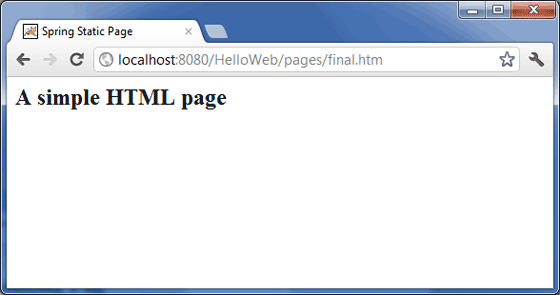Spring MVC-静态页面示例(转载实践)
以下内容翻译自:https://www.tutorialspoint.com/springmvc/springmvc_static_pages.htm
说明:示例基于Spring MVC 4.1.6。
以下示例显示了如何使用Spring MVC Framework编写一个简单的基于Web的应用程序,该MVC框架可以在<mvc:resources>标签的帮助下访问静态页面以及动态页面。首先,让我们使用Eclipse IDE,并按照以下步骤使用Spring Web Framework开发基于动态窗体的Web应用程序:
| 步骤 | 描述 |
|---|---|
| 1 | 创建一个名为HelloWeb的项目,在一个包com.tutorialspoint下,如Spring MVC - Hello World Example章节所述。 |
| 2 | 在com.tutorialspoint包下创建一个Java类WebController。 |
| 3 | 在jsp子文件夹下创建一个静态文件final.htm。 |
| 4 | 如下所述,在WebContent/WEB-INF文件夹下更新Spring配置文件HelloWeb-servlet.xml。 |
| 4 | 最后一步是创建所有源和配置文件的内容并导出应用程序,如下所述。 |
WebController.java
package com.tutorialspoint; import org.springframework.stereotype.Controller; import org.springframework.web.bind.annotation.RequestMapping; import org.springframework.web.bind.annotation.RequestMethod; @Controller public class WebController { @RequestMapping(value = "/index", method = RequestMethod.GET) public String index() { return "index"; } @RequestMapping(value = "/staticPage", method = RequestMethod.GET) public String redirect() { return "redirect:/pages/final.htm"; } }
HelloWeb-servlet.xml
<?xml version="1.0" encoding="UTF-8"?> <beans xmlns="http://www.springframework.org/schema/beans" xmlns:xsi="http://www.w3.org/2001/XMLSchema-instance" xmlns:context="http://www.springframework.org/schema/context" xmlns:mvc="http://www.springframework.org/schema/mvc" xsi:schemaLocation="http://www.springframework.org/schema/beans http://www.springframework.org/schema/beans/spring-beans-2.5.xsd http://www.springframework.org/schema/mvc http://www.springframework.org/schema/mvc/spring-mvc-3.0.xsd http://www.springframework.org/schema/context http://www.springframework.org/schema/context/spring-context-3.0.xsd"> <context:component-scan base-package="com.tutorialspoint" /> <bean id="viewResolver" class="org.springframework.web.servlet.view.InternalResourceViewResolver"> <property name="prefix" value="/WEB-INF/jsp/" /> <property name="suffix" value=".jsp" /> </bean> <mvc:resources mapping="/pages/**" location="/WEB-INF/pages/" />
<mvc:annotation-driven/> </beans>
这里使用<mvc:resources .... />标签来映射静态页面。映射属性必须是一个Ant图案指定一个HTTP请求的URL模式。该位置属性必须指定为静态页面,包括图片,样式表,JavaScript和其它静态内容的一个或多个有效的资源目录位置。可以使用逗号分隔的值列表来指定多个资源位置。
以下是Spring视图文件WEB-INF/jsp/index.jsp的内容。这将是一个登陆页面,此页面将发送访问staticPage服务方法的请求,该方法将将该请求重定向到WEB-INF/pages文件夹中可用的静态页面。
index.jsp
<%@taglib uri="http://www.springframework.org/tags/form" prefix="form"%> <html> <head> <title>Spring Landing Page</title> </head> <body> <h2>Spring Landing Pag</h2> <p>Click below button to get a simple HTML page</p> <form:form method="GET" action="/HelloWeb/staticPage"> <table> <tr> <td> <input type="submit" value="Get HTML Page"/> </td> </tr> </table> </form:form> </body> </html>
final.htm
<html> <head> <title>Spring Static Page</title> </head> <body> <h2>A simple HTML page</h2> </body> </html>
完成创建源和配置文件后,导出应用程序。右键单击应用程序并使用Export->WAR File选项,并将您的HelloWeb.war文件保存在Tomcat的webapps文件夹中。
现在启动您的Tomcat服务器,并确保您可以使用标准浏览器从webapps文件夹访问其他网页。现在尝试访问URL http://localhost:8080/HelloWeb/index。如果您的Spring Web应用程序一切正常,您应该看到以下结果:

点击“获取HTML页面”按钮访问staticPage服务方法中提到的静态页面。如果您的Spring Web应用程序一切正常,您应该看到以下结果:

Maven示例:
https://github.com/easonjim/5_java_example/tree/master/springmvc/tutorialspoint/test3

